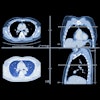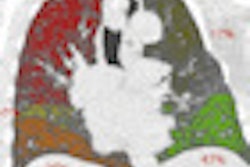Image quality in coronary CT angiography (CCTA) studies degrades significantly in heavier patients, and increasing the tube current doesn't alter that relationship, according to a new study in the American Journal of Cardiology.
CCTA studies using a reduced tube current of 100 kV "have successfully reduced the exposure of CTA by ≥ 50%," wrote John Ho, MD, Carolyn Barlow, and colleagues, from the Cooper Clinic and Cooper Institute in Dallas. "This strategy, however, has generally been recommended for nonobese and nonoverweight patients." Particularly among the heaviest patients in the cohort, the researchers found that adequate mAs couldn't compensate for reduced kV settings (Am J Cardiol, October 15, 2010, Vol. 106:8, pp. 1182-1186).
Use of the 100-kV setting increases image noise and could degrade images unacceptably, and its effects on overweight or obese patients are unknown, they wrote. The study aimed to evaluate the effect of higher body mass index (BMI) on image quality of 100-kV coronary CTA. In addition, the researchers also compared the radiation dose and diagnostic accuracy of 100-kV CTA versus 120-kV CTA.
The study included 914 patients (mean age, approximately 62 years) who had been referred for coronary CTA, including 302 patients in the 120-kV retrospective-gating protocol, 253 in the 100-kV retrospective protocol, and 359 in the 100-kV prospective protocol. Patients were excluded for atrial fibrillation and other contraindications to coronary CTA.
CTA was performed on a 64-detector-row LightSpeed VCT scanner (GE Healthcare, Chalfont St. Giles, U.K.) at 0.6-mm collimation, following injection of 90-100 mL of iodinated contrast at 5-6 mL/sec at 300-400 mA. Tube current (mA) was based on the patient's BMI:
- 300 mA for BMI < 25 kg/m2
- 350 mA for BMI 25-30
- 400 mA for BMI 30-40
- 450 mA for BMI > 40
Thin-slab maximum intensity projections (MIPs) and the curved multiplanar images were reconstructed for reading; transaxial images were reconstructed at a 0.6-mm slice width. Retrospective CTA exams included multiphase reconstructions at 10% increments from 5% to 95% of the RR interval for ejection fraction calculation and 5% increments from 70% to 80% for the assessment of stenoses. Prospective CTA used reconstructions at middiastole at 75% of the RR interval.
Two experienced readers interpreted each case independently, and patients with significant stenoses were referred for angiography. The radiation dose was defined as the summation of the dose-length product of the calcium scoring scan, timing bolus scan, and, finally, the contrast-enhanced CTA scan. Angiography results were correlated with CTA findings to determine positive predictive value for each protocol.
Study participants consisted primarily of older, overweight men who were largely asymptomatic. Only 1% exhibited angina and less than 13% had atypical chest pain. The median coronary artery calcium score was 469 (Agatston); however, several other risk factors were present including hypertension in 53.2%, a history of tobacco use in 43.6%, and hyperlipidemia in 83%.
In the 100-kV prospective group, the median coronary artery calcium score was significantly lower, a greater number of patients had diabetes, and a greater number had an atypical chest pain presentation, the authors wrote. The cohorts for the 120-kV (n = 287), 100-kV retrospective (n = 253), and 100-kV prospective (n = 359) groups had no significant differences in stress test findings, frequency of angina, or perfusion study abnormalities.
The results showed decreasing image quality and dose with reduced tube current voltage and increasing BMI:
|
||||||||||||||||||||||||||||||||||||||||||||||||||||
| Increasing BMI and decreasing tube voltages led to worsening of the noise, contrast-to-noise, and signal-to-noise ratios, while decreasing tube voltages reduced radiation doses significantly, in data presented as mean ± standard deviation. | ||||||||||||||||||||||||||||||||||||||||||||||||||||
In a previous study, Hussman and colleagues found, similarly, that contrast-to-noise ratio decreased as BMI increased, and they noted an inverse relationship between contrast-to-noise ratio and body surface area. Both increased contrast volume and increased tube voltage have been proposed as solutions.
"Because a lowered tube voltage could compound the image degradation seen with obesity, investigators have been reluctant to use a 100-kV voltage in those with a BMI of ≥ 26 kg/m2," Ho and colleagues wrote. Nevertheless, they said, Hausleiter and his team demonstrated the feasibility of 100-kV CCTA in patients with a mean BMI of 25.6 kg/m2. And Pflederer and colleagues found that the signal-to-noise ratio and contrast-to-noise ratio of 100-kV CTA were not significantly different from those of 120-kV CCTA. Other studies have also found acceptable image quality.
"In contrast to their findings, we found some degradation in the various image parameters as the tube voltage was decreased from 120 to 100 kV," the authors wrote. "It is unclear why our results differed from those of the other reports." Two differences that could explain this discrepancy included the higher mean BMI and the significantly lower effective tube current compared to the previous studies.
Image quality degrades as BMI increases, irrespective of the tube voltage, but remained adequate for diagnostic purposes in most patients. In all, 55 of 65 subjects referred for invasive angiography due to CCTA findings were correctly characterized, for an overall positive predictive value (PPV) of 83.3%.
The PPV remained "reasonable" until a BMI of 35 kg/m2 was reached (PPV for 100-kV protocol = 90.0%; PPV for a BMI of 25-30 = 84.4%; PPV for a BMI of 30-35 = 81.8%), Ho and colleagues wrote.
"100-kV coronary CTA is feasible in overweight and many obese subjects," the authors concluded, adding that the radiation dose for 100-kV prospectively triggered scans was a very low 1.8 mSv including the noncontrast scan, test bolus scan, and CCTA, which "should allay recent concerns regarding an increased risk of radiation-induced malignancy."
The study limitations included a lack of negative predictive values because patients without significant disease could not be ethically referred for invasive angiography.
By Eric Barnes
AuntMinnie.com staff writer
October 12, 2010
Related Reading
Few adverse events occur a year after negative cardiac CTA, September 21, 2010
ASIR cuts dose by 27% in coronary CT angiography, August 20, 2010
Body mass index predicts left atrial thrombus in atrial fibrillation, December 31, 2009
Prospective coronary CTA performs well in heavy patients, February 27, 2009
When zoos refuse: Obese patients face shortage of large-capacity scanners, September 24, 2008
Copyright © 2010 AuntMinnie.com




















